Don't wanna be here? Send us removal request.
Text
Tax Settings in MyPosBook - All-in-One-ERP Software & ERP Solutions
Tax Settings in MyPosBook - All-in-One-ERP Software & ERP Solutions for Business
Tax Rates, Tax Groups & Disabling tax Setting MyPosBook for Indian Users or other Country with GST support. Inline tax & invoice tax 1. Tax Rates, Tax Groups & Disabling tax Tax Rates To add new tax go to Settings -> Tax Rates -> Add Add a descriptive name (eg: “VAT@5%”) and specify the “Tax Rate%” Tax Groups Sometime you will need to apply multiple taxes to an invoice or purchase. So you should create tax groups by combining multiple taxes. To add a Tax Group – Click on Add Button, Give a meaningful name, select the tax you want to use in this tax group. The tax rate of tax group will be the sum of tax rates of Sub-taxes added. If sub-tax is edited the corresponding tax group’s tax rate will also get updated accordingly. You cannot delete a Tax if it is used in a Tax Group. Disable Tax Don’t add Tax Rates in settings Go to Settings – Business Settings. Uncheck “Enable inline tax in purchase and sell“ Uncheck “Enable Price & Tax info“ Select “Default Sale Tax” as None NOTE: If you disable the inline tax in the purchase and sell, the Price Inc tax column will not be shown in the POS screen. 2. Setting MyPosBook for Indian Users or other Country with GST support Tax settings: 3 Different taxes in India: CGST (Central Goods & Services Tax) SGST (State Goods & Services Tax ) IGST (Integrated Goods & Services Tax) Go to Settings -> Tax Rate setting. 1. Create a tax with name CGST@10% and Tax Rate %: as 10. (10% is for example only, use the tax rate applicable) 2. Create a tax with name SGST@10% and Tax Rate %: as 10. (10% is for example only, use the tax rate applicable) 3. Create a tax with name IGST@14% and Tax Rate %: as 14. (14% is for example only, use the tax rate applicable) 4. Below Tax rate, it shows “Tax groups ( Combination of multiple taxes )”. Create on Add, enter the tax group name as Intra-State-CGST-SGST and select sub-taxes CGST@10% & SGST@10%. 5. Below Tax rate, it shows “Tax groups ( Combination of multiple taxes )”. Create on Add, enter the tax group name as Inter-State-IGST, and select sub-taxes IGST@14%. With this now when you purchase or sell a product you can select the applicable tax. Displaying HSN Code for items (For some businesses) 1. HSN code depends on the category of a product. 2. Go to Settings -> Categories, click on “Add”. Add category name and category code. Category code is same as HSN code. 3. To display HSN code in invoice – Go to Settings -> Invoice Settings -> invoice layouts. Add/Edit invoice layout and click on ” Show category code or HSN code”. Save it. Assing that invoice layout to your business. Setting up invoice format for GST Check the details guide on invoice format & designs To display the summary of tax in the invoice – add the label for “Tax Summary Label” To see inline tax try using the columnized tax design or detailed design or Elegant or classic as per your need. 3. Inline tax & Order/Invoice tax With MyPosBook you can configure the inline and order/invoice tax. To Enable inline tax. Go to Settings -> Business settings – Taxes Click on Enable Inline Tax in purchase and Sell. Then click Update settings To Enable Invoice Order tax. Go to Settings -> Business settings – POS Click on Order Tax Then click Update settings FAQ? What is difference between inline tax and Order Tax? Inline Tax is applied to Product level, if product have different type of tax. Order Tax is applied against the order of the invoice, not at the individual product level Read the full article
0 notes
Text
Business Settings in MyPosBook-ERP Software & ERP Solutions
Business Settings in MyPosBook - All-in-One-ERP Software & ERP Solutions for Business
Business / Store Settings Setting Invoice Scheme Setting default Language, Changing Language preference and Adding/Editing Translations Adding a new Label or barcode settings Changing the custom fields labels Changing Application/theme Color 1. Business / Store Settings Business Settings allows you to set some of the common business-related information. Here you can change: Business name Start Date Set Default Profit margin Currency Time zone Logo Financial year: For some countries, the financial year starts from January and for some it stars on April. Here you can set the appropriate option for your country. Tax information Product SKU prefix: Enable this feature to generate a prefix for Product SKU. Once enabled, while adding a new product the SKU field with add this prefix along with the input given or if left empty will autogenerate a value along with this prefix. Default Sales discount Default Sales tax Business Setting > Contact > Default credit limit: The credit limit provided here will be used as default value when creating a customer or supplier Business Setting > Sale > Default Sale Discount: The default discount will be used for all sales in POS & Add sales screen. Sales: Sales Item Addition Method: It has 2 options: “Add item in new row” & “Increase item quantity if it already exists” This option is related to POS & Sales screen when a new product is added. Add item in new row: It will always add a product in new row Increase item quantity if it already exists: If the product already exists in the cart it will increase its quantity else it will add it in a new row. Amount rounding method: The price of the products can be taken as a whole number or as a rounded decimal value by selecting the particular roundoff method. If none is selected the value is taken as a whole number.
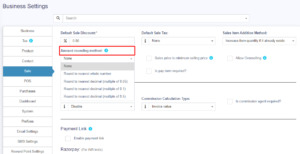
MyPosBook – All-in-one ERP Software System & Solution for Business, Best advanced stock inventory management, warehouse management, point of sale, invoicing & accounting application comes with lots of features out-of-box. You get most of the feature needed by small & medium sized businesses to simplify the time-consuming task of accounting & inventory management and instead focus on what really matters – Your Business. Sales price is minimum selling price: If this option is enabled then the product cannot be sold at a price lower than the selling price set for the product. It can be sold at a higher price but not at a lower price. Enable inline Tax: To display the price inc. tax on the POS screen, kindly enable the check box in the Business Settings->Tax.
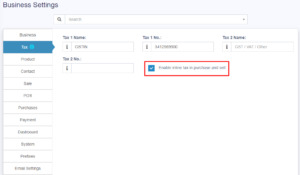
MyPosBook – All-in-one ERP Software System & Solution for Business, Best advanced stock inventory management, warehouse management, point of sale, invoicing & accounting application comes with lots of features out-of-box. You get most of the feature needed by small & medium sized businesses to simplify the time-consuming task of accounting & inventory management and instead focus on what really matters – Your Business. Enable Sales Order: This will enable the sales order feature. Default Sale Discount: The default sale discount can be added to products in Business Settings -> Sale
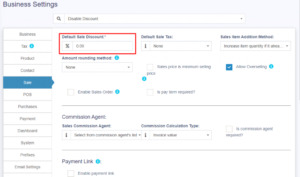
MyPosBook – All-in-one ERP Software System & Solution for Business, Best advanced stock inventory management, warehouse management, point of sale, invoicing & accounting application comes with lots of features out-of-box. You get most of the feature needed by small & medium sized businesses to simplify the time-consuming task of accounting & inventory management and instead focus on what really matters – Your Business. Limit for Transaction Edit: In order to increase the limit for editing the transaction, set the number of days in the business settings. Data table Entry Selection: The default number of entries in the data tables can be selected in Business Settings -> System.

MyPosBook – All-in-one ERP Software System & Solution for Business, Best advanced stock inventory management, warehouse management, point of sale, invoicing & accounting application comes with lots of features out-of-box. You get most of the feature needed by small & medium sized businesses to simplify the time-consuming task of accounting & inventory management and instead focus on what really matters – Your Business.
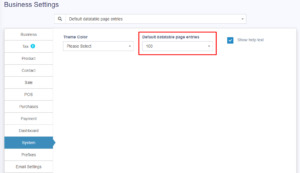
MyPosBook – All-in-one ERP Software System & Solution for Business, Best advanced stock inventory management, warehouse management, point of sale, invoicing & accounting application comes with lots of features out-of-box. You get most of the feature needed by small & medium sized businesses to simplify the time-consuming task of accounting & inventory management and instead focus on what really matters – Your Business. 2. Setting Invoice Scheme With MyPosBook you can configure the format for your invoice number. To configure go to Settings -> Invoice settings Click on Add and select a scheme format. Format can be XXXX or -XXXX You can also provide a custom prefix, invoice start number, number of digits in the invoice number. The preview box will display the preview according to the chosen option. You will need to set a default invoice scheme for a business to use it. 3. Adding new label or barcode settings MyPosBook comes with some commonly used barcode configurations for you our-of-box. If your barcode configuration isn’t covered then you can easily create a new configuration. You must have all measurement details of the sticker to create a configuration. All dimensions need to be in inches. Adding Barcode sticker settings Go to settings -> Barcode Settings -> Add Enter a descriptive name of the setting. Add some description for your information. If you’re using a Roll, then check the “Continous feed or rolls” checkbox. Enter Additional top margin (In Inches), Additional left margin (In Inches), width of the sticker, Height of the sticker, Paper width, Paper height, number of stickers in one row, distance between 2 rows, distance between 2 columns and the total number of stickers per sheet. Some of this information’s are not needed for Continuous feed or rolls. You must test you setting by printing a dummy sticker in Purchase – print label option. If something seems wrong then edit the measurement accordingly. 4. Changing the custom fields labels To modify the labels of custom fields, go to Settings -> Business Settings -> Custom Labels Here you can give names to all custom fields. 5. Changing Application/theme Color To change Application or Theme color follow the below steps: Go to Settings -> Business Settings -> System (tab) Change the Theme Color to your desired color. A total of 11 colors (Light & Dark options) are given Read the full article
0 notes
Text
User Management in MyPosBook-All-in-One-ERP Software & ERP Solutions
User Management in MyPosBook - All-in-One-ERP Software & ERP Solutions for Business
Adding User & assigning location to a user Role Management Using Commission Agent feature 1. Adding User & assigning location to a user Adding users User Management -> Users -> Add New Fill the user details, select user role, give a unique username. Sales Commission Percentage (%): Provide the commission % for this user. This option gets applied if the commission agent feature is enabled. Is active?: Activate/Deactivate the user. You can edit/delete a user. Assign locations Refer to the image below Max sales discount: The maximum discount this user can give during sales in the POS & sales screen. If you don’t want to have this restriction then simply keep this value blank. Disable login Refer to the image below

MyPosBook – All-in-one ERP Software System & Solution for Business, Best advanced stock inventory management, warehouse management, point of sale, invoicing & accounting application comes with lots of features out-of-box. You get most of the feature needed by small & medium sized businesses to simplify the time-consuming task of accounting & inventory management and instead focus on what really matters – Your Business. 2. Role Management Adding Roles Every new business comes with some default roles – Admin & Cashier. Admin have all permissions in the application. Cashier have permission to only POS section. You can create a role by clicking on Add button -> Giving a role name and then selecting the appropriate permission for that role. Sometime you may need to give a user access to a/some particular location(s) only. In this case, select the locations from “Access locations” permission. Select “All Locations” to give permission to access all locations for your business. Roles permissions can be edited & Deleted. Note: You must update the role of an existing user before deleting a role. 3. Using Commission Agent feature Enabling & Choosing Commission Agent Type: By default Commission Agent is Disabled. You can enable it from Settings -> Business Settings -> Sales. Sales Commission Agent drop-down. You will see 3 different types: Logged in User: If this option is used then the Logged in User will be automatically considered as the commission agent for the sales added by him. Meaning the user adding the sales will get the commission for the sales. Select from User’s List: If this option is enabled then in POS & Sales Screen you will see the list of “users” present in your business. The user adding the sales will select the commission agent from the list of users displayed. Select from Commission Agent List: If this option is enabled then in POS & Sales Screen you will see the list of “Sales Commission Agents” present in your business. The user adding the sales will select the commission agent from the list of “Sales Commission Agents” displayed. Select the option as per your business requirements. Adding Commission Percentage: You can add commission % while adding/editing the User or Sales Commission Agent Calculating Commission Amount: To See the commission amount, Go to Reports -> Sales Representative Report. Select the User for which you want to see the commission amount. On selecting it will show you the detailed summary of Total Sale, Total Sale Commission & Total Expense. Also, the table below lists all the transactions. NOTE: Sales commission is calculated without shipping or tax. Sales commissions are from the sales of the items, not the overhead cost such as taxes, freight, shipping, handling, etc. Commission payment: After getting the commission amount, UltimatePOS have 2 ways to make payment for the commission. Using expense Calculate the commission from the sales representative report and after paying the amount add it as an expense in Add Expense menu. In Add expense, select the Expense-For dropdown Using HRM module Use the HRM Module(To Purchase Separately) In the HR module, when creating payroll for a user, it will automatically include the sales commission. Sales commission will be shown as Payroll-Components so that the business owner and the user both know details of the commission. Read the full article
0 notes
Text
Property Management Software to Manage Rental Properties & Assets
How to use Property Management Software used by property owners and managers to manage rental properties and assets.
Introduction
What is Property Management Software ? Property Management Software Our property management software streamlines the day-to-day operations of property owners and managers. With features like online rent payments, maintenance requests, and lease tracking, this software makes it easy to manage multiple properties from one centralized platform. Say goodbye to manual processes and hello to increased efficiency and profitability with our property management software. The software has three different panels - Owner, Maintainer, and Tenant. We’ll get to the details of every panel in this documentation. So let’s start with the basics. How Property Management Software Works? This platform has three panel (Owner, Maintainer, Tenant) and description here An Owner can:- In Property Management Software, an Owner is a user with the most access, permissions, and responsibilities. To run the software, the Owner must handle the entire system. Owner can add, edit and delete the own properties, Leased Properties, Units. Also add, edit or delete the tenant. add, edit or delete the maintainers. Also able create the invoice, tenant agreement and expenses. send the reminders and many more features. Owner Dashboard is an analysis overview of entire property like how many tenant, many property units vacant, total property details, monthly earning and expenses etc.. A Maintainer can:- In Property Management Software, Maintainer can Receive and respond to maintenance requests from tenants, track request status and completion, and schedule maintenance work. An Tenant can:- In Property Management Software, A tenant can perform the following tasks in a property management software: 1.Rent Payment: Make rent payments online, view payment history, and set up automatic payments. 2.Maintenance Requests: Submit maintenance requests, track request status, and receive updates on completion. 3.Communication: Send and receive messages to the property manager or maintenance staff. 4.Lease Management: View lease details, including lease terms, renewal dates, and rent payment schedule. 5.Document Management: Access and download important documents related to the rental property, such as the lease agreement and building rules. 6.Bill Payment: View and pay bills for utilities and other services associated with the rental property. 7.These are some of the common tasks that a tenant can perform in a property management software. The exact features will depend on the specific software being used. Read the full article
0 notes
Text
Purchase Management in MyPosBook-ERP Software & ERP Solutions
Purchase Management in MyPosBook - All-in-One-ERP Software & ERP Solutions for Business
Purchase Payments Purchase Order Adding Bonus or Free Items given by supplier Purchase custom fields 1. Adding Purchase Adding Purchase Go to – Purchases -> Add Purchases Type Supplier Name or Business name in the Supplier field. If the supplier doesn’t exist you must add them from Contacts -> Suppliers -> Add Enter Purchase reference number, Purchase date & Order Status. Select Business Location: Select a location where you want to add the purchase. You can add a new Location from Settings -> Business Locations. Type product name or scan the product barcode number. It will show related matched products, select a product to add it to the purchase list. On adding a new product you can enter purchase quantity, purchase price, and tax information. To add a discount: Select the discount type (fixed or percentage) and enter the amount. ultimatePOS will auto-calculate the amount after discount. Enter purchase tax, Shipping Details, Additional Shipping charges, Payment status, & Additional notes. You can view the list of purchases from Purchases -> List Purchases. You can Print Labels for your purchase by Clicking “Print Labels” in List Purchases screen. No matching product found This error will be displayed in 3 conditions: Reason 1: There are no products matching the name or SKU which you have entered. Check it once in the list products. Reason 2: Check the business location selected in add purchase have that product. So if the business location is Location-1, then in add/edit product the product must be assigned to that location. Reason 3: Make sure the product has Stock-Management ENABLED in Add/edit product. If stock management is not enabled in products then it won’t show in the add/edit purchase. 2. Purchase Payments Purchase payment meaning paying to the supplier for the Purchases. Payments Statuses Paid: The PO is 100% paid. Due: The PO is 100% not paid. Partial: Partial amount of the PO has been paid. Overdue: PO is 100% not paid & past the due date. Partial Overdue: Partial amount of the PO has been unpaid & past the due date.

MyPosBook – All-in-one ERP Software System & Solution for Business, Best advanced stock inventory management, warehouse management, point of sale, invoicing & accounting application comes with lots of features out-of-box. You get most of the feature needed by small & medium sized businesses to simplify the time-consuming task of accounting & inventory management and instead focus on what really matters – Your Business. Adding Payments Adding payment when adding purchase: In the add purchase screen, you can add the payment for the purchase. Adding payment from the List Purchase screen In list purchase click the actions for any PO and it will display the list of actions for it. This option is not displayed if there is no payment due.
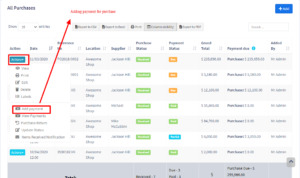
MyPosBook – All-in-one ERP Software System & Solution for Business, Best advanced stock inventory management, warehouse management, point of sale, invoicing & accounting application comes with lots of features out-of-box. You get most of the feature needed by small & medium sized businesses to simplify the time-consuming task of accounting & inventory management and instead focus on what really matters – Your Business. Adding payments from Contact Go to contact -> Suppliers. Click on actions for the supplier and it will show “Pay Due amount”, click on it and pay the amount. “Pay Due amount” this option is not displayed if there is no payment due.

MyPosBook – All-in-one ERP Software System & Solution for Business, Best advanced stock inventory management, warehouse management, point of sale, invoicing & accounting application comes with lots of features out-of-box. You get most of the feature needed by small & medium sized businesses to simplify the time-consuming task of accounting & inventory management and instead focus on what really matters – Your Business. 3. Purchase Order What is a Purchase Order? A purchase order is a document given by the buyer (usually you) to the supplier to request a purchase of goods. A purchase order contains the buyer invoicing details, delivery details, products, quantities, pricing, tax, discounts, payment terms, payment details, shipping charges if any, and other notes. The supplier will issue a sales order against the purchase order you have provided. A purchase order has multiple statuses: Ordered, Partial, Completed Enabling Purchase Order To enable purchase Order, follow the below steps: Go to Settings -> Business Settings Purchase tab -> Enable Purchase Order Save it. Using Purchase Order in MyPosBook Creating purchase order After Enabling Purchase order, inside Purchase you’ll find the Purchase -Order menu. Go to add Purchase order, fill in all the details and save it. Stocks are not added on issuing Purchase orders. Once a Purchase order is created you can print it and send it to the supplier. Converting purchase Order to Purchase On receiving Purchase orders the supplier issues a sales or invoice. Go to Purchase -> Add Purchase, select the supplier. On Selecting it will populate the list of all Purchase orders related to the supplier on the “Purchase Order” dropdown. Select the Purchase Order and it will auto load the products for that order with the product’s price, tax, discounts applied automatically as the sales order. You can increase or decrease the quantity. Save it and the status of the Purchase order will change automatically.
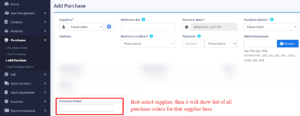
MyPosBook – All-in-one ERP Software System & Solution for Business, Best advanced stock inventory management, warehouse management, point of sale, invoicing & accounting application comes with lots of features out-of-box. You get most of the feature needed by small & medium sized businesses to simplify the time-consuming task of accounting & inventory management and instead focus on what really matters – Your Business. 4. Adding Bonus or Free Items given by supplier Adding Bonus Items or Free items given by Suppliers 2 ways you can do this: Solution 1: When adding purchases simply make purchase price 0 for the free items. Solution 2: Find the average price of the item and use that for unit price. for example, if you purchase 10 quantity for a price of $2 each, 10X2 = $20 and get 2 quantity free, then the average cost of each will become 20/12 = $1.66 5. Purchase custom fields You can add some custom fields in add/edit purchase & view purchase. To enable custom fields: Go to settings -> Business settings -> Label for purchase custom fields: Provide a label for the fields you need, fields will automatically get enabled once the label is added. Check “Is required” checkbox to make the field as required in add/edit purchase. Read the full article
0 notes
Text
Business Analytics Reports in MyPosBook-ERP Software & ERP Solutions
Business Analytics Reports in MyPosBook - All-in-One-ERP Software & ERP Solutions for Business
Reports help you to get an overview of your entire business. To view report click on Reports & Select the report you want to view. Some Reports come filter relevant options to help you analyze your business better. 1. Reports Reports help you to get an overview of your entire business. To view report click on Reports & Select the report you want to view. Some Reports come filter relevant options to help you analyze your business better. Purchase & Sale Report This report shows the total purchase, Purchase Including tax, Purchases with Dues amount; and Total Sale, Sale Including tax, Sale Due. Tax Reports Shows the Input & Output Taxes. Contacts Report(Customers & Suppliers Reports) This report shows the details of Purchase & Sell with all contacts (Suppliers & Customers) and also any Due amount. Positive Due amount indicates payment by contact, negative indicates payments to the contact. Stock Report The stock report displays the stock details. With this, you can track the remaining stock and total sold quantity sold for all products. For variable products – you can click on the Green Plus button before the SKU column to get details stock reports for each product variations. Stock value by Purchase & sales price In the stock report, you can also get information about the current stock value based on their purchase price & value based on selling price. Check the below screenshot of stock report.

MyPosBook – All-in-one ERP Software System & Solution for Business, Best advanced stock inventory management, warehouse management, point of sale, invoicing & accounting application comes with lots of features out-of-box. You get most of the feature needed by small & medium sized businesses to simplify the time-consuming task of accounting & inventory management and instead focus on what really matters – Your Business. Trending Products Report This report helps you to determine the demand of the products. You can apply different filters to filter the product. Select a Business Location to view trends for a particular business location. Select Product Category, Sub-Category, Brands, Units, Date Range to filter them. Set “No. of products” to view the top that amount of product. Using this you can view Top 5, Top10 or any number of top products. Expense Report Expense report helps you to analyze expenses for business locations and also analyze based on expenses categories. Register Report View details of all registers and filter registers based on User and/or Status (Open or Closed) Sales Representative Report View Sales and Expenses details of Sales representative Filter them with User, Business Location, Date Range Read the full article
0 notes
Text
Accounts Management in MyPosBook-ERP Software & ERP Solutions
Accounts Management in MyPosBook - All-in-One-ERP Software & ERP Solutions for Business
Enabling & using Payment account or bank account Setting default payment accounts for payment methods 1. Enabling & using Payment account or bank account What is payment accounts in MyPosBook? Payment accounts are like for example bank account. You can transfer money from one payment account to another, deposit cash in payment account, pay to a supplier, or deposit the amount received from a customer here. Enabling Payment account Go to Settings ->Business Settings -> Modules Enable payment ‘Account’ option Save it. After saving you will see the “Payment accounts” option will be visible in the left navigation bar. Payment account type & sub-type Go to Payment accounts -> List accounts -> Account Types Account type: to add an account type click on Add button and enter the name of the account type and submit. Keep the Parent account type unselected. Sub-Account type: To add a sub-account type click on Add button, enter the name of the sub-account type and select the Parent-account-type. When creating an account you can select the account type as per your need. Creating Payment accounts To create a payment account, Go to Payment Accounts -> List Accounts, click on Add button Fill in all the details like name, account number, Account type, opening balance, Account details & notes. Account Details: Here you can add any additional account details, like for example UPI ID, SWIFT code, BIN number, etc which vary depending on the accounts. Transferring funds between Payment accounts: You can transfer funds between the payment accounts. In the Payment Accounts -> List Accounts, click on fund transfer.

MyPosBook – All-in-one ERP Software System & Solution for Business, Best advanced stock inventory management, warehouse management, point of sale, invoicing & accounting application comes with lots of features out-of-box. You get most of the feature needed by small & medium sized businesses to simplify the time-consuming task of accounting & inventory management and instead focus on what really matters – Your Business. 2. Setting default payment accounts for payment methods MyPosBook allows you to add expenses for an employee. Thie expenses can be Salary, Bonuses, Perks, travel expenditure or anything else. – Simply create a category for the expense you’re adding. Adding relevant categories helps you to classify expenses and analyze them. – Go to Add Expenses, fill the details, select the relevant category and select the employee name expense for fields. – Add the expense. – To view details of all expenses for an employee go to “Sales Representative Report” and select the User. It will show the total expenses for the employee. You can also view the list of expenses from there. Expense for Contact (Customer or Supplier): To add expense for a customer or supplier select the customer/supplier name from the expense for contact dropdown Read the full article
0 notes
Text
ERP Software & ERP Solutions - MyPosBook - User Guide
- Click on register business link on the welcome page. https://erp.myposbook.com/public/business/register - Registering business involves multiple steps; Business Details, Tax details, and Owner details. - Business Details: Fill out the relevant fields; select the appropriate currency & Time zone; click on Next. Time Zone & Currency can be different for different registered businesses. - Tax Details: You should fill out at least one Tax name and Tax number. Tax is like GST/VAT which varies for different countries. Fill details & click on next. - Owner Details: Provide asked details. Username & Password are used to login so make sure you remember them. - The owner created during this registration will be admin of the business. More admin can be added/edited/deleted from user management section. - Click on the register button and after successful registration, it will get redirected to login screen. Login with owner username/password created. MyPosBook comes with the option to handle multiple business locations or Warehouse or Storefronts for your business. - To create a new Business Location / Storefront or warehouse go to “settings -> Business Locations” - Fill the business details. - Choose an Invoice scheme & Invoice Layout for the location.– When having multiple locations you will have to select the Location while adding purchases or in the pos screen. - Inventory and transactions are managed separately for each location you create so that you can easily track and analyze them for each location. - Disabling Business Location:To disable a business location click on Disable button present in List Business Location.NOTE 1: After a business location is disbabled any users assigned to that business location must be assigned to other non-disabled business location.NOTE 2: You must keep atleast 1 business location non-disabled. If all business location is disabled then the application will throw errors. With MyPosBook you can configure the format for your invoice number. To configure go to Settings -> Invoice settings - Click on Add and select a scheme format. Format can be XXXX or -XXXX - You can also provide a custom prefix, invoice start number, number of digits in the invoice number. - The preview box will display the preview according to the chosen option. - You will need to set a default invoice scheme for a business to use it. Invoice Layout Invoice Layout helps you to create different invoice formats. To add a new invoice layout: - Go to Settings->Invoice Settings->Invoice Layout->Add - Give a unique distinguishable Layout name - Add the text to be shown in the top/header of invoice. Generally, it can be your shop name, aligned center with Heading 1 format. - Add other relevant details. - You can show/hide address fields. - You can mark a layout as default. The default layout is used when no layout is found for a location. - Click on Save. To use an invoice layout in a location go to” Business Locations -> Edit” and assign the invoice layout. Invoice Design: - In invoice layout, you will find options for invoice designs. - Used for browser-based printing only & NOT print server-based printing. - Slim design is used for thermal line printer-based printer. Changing invoice layout Select the invoice design name of the design you want to change like classic/elegant/detailed/slim etc. Tax Summary: To see the tax summary in invoice, go to add/edit invoice layout, and enter the “Tax Summary Label” option and it will show the tax summary in invoice. Total in words: To display total in words in the invoice Enable: - Show total in words - Choose “Word Format” Discounted Price: To display the discounted unit price and discount amount in the invoice, enable the following filed in invoice layout - Discounted unit price label - Discount label Display unit breakdown: To display the reduction summary of quantity from multiple units, enable the check box ‘show base unit details (If applicable)’. With MyPosBook we aim to make it “One in All” POS/Stock Management Application. Selling price groups allow you to add different prices for a product. - Sell at different prices: wholesale/retail - Different prices for different locations Adding Selling Price Groups: - Go to products -> Selling Price Group - Click on “Add” button to add a new price group. For example Retail price or WholeSale price or Bulk Purchase price or Location 1 price etc as per your wish. - You can view a list of selling prices in “Selling Price Group” screen. Adding price for different price groups:

MyPosBook - All-in-one ERP Software System & Solution for Business, Best advanced stock inventory management, warehouse management, point of sale, invoicing & accounting application comes with lots of features out-of-box. You get most of the feature needed by small & medium sized businesses to simplify the time-consuming task of accounting & inventory management and instead focus on what really matters – Your Business. - In Add/Edit product screen in the bottom, you will find the button “Save & Add Selling-price-group price”. Click on that button. Note: this button will not be visible if there are no selling price groups. - In the next screen, you will see the list of the product name (if variable product then all variations), the default price & selling price groups price. Enter the prices for it. - Click on Save. Exporting & Importing selling price group: - Go to Products -> Selling Price Group. - First download the excel file with the selling price group by clicking on “Export Selling Price Group Prices” button. - In the downloaded file change the price of products. - Only selling price group prices of the product will be updated, not the SKU or name. - Any blank price will be skiped. - Then import the file. Selling at a particular price group: - Go to POS. - In the top, you will see the list of selling price groups. Select the one as per your requirement. Note: This will not be visible if there are no selling price groups or if a user is assigned only one particular price group only. - Select the prie group & the selling prices for the product will be as per the price group. Assigning a user to a particular price group: - Sometime you may want to assign a particular or few selected price group to a user. In that case, create a role with the desired permission & price group assigned. - You must assign at least one price group for a role if that role has permission to sell. Assigning a price group to a Business Location - Helps selling same product at a different price in different business location. - Go to Add/Edit Business Location and select the Default Selling Price Group, if not selected then products default price will be used. FAQ? 1. How to hide the Selling Price Group in POS window to all cashiers In add/edit roles you can set which all selling price groups will be visible to that role. So in the cashier role, you can uncheck/remove permission for all other selling price groups except the one you want to show or use for the cashier.
Tax Rates - To add new tax go to Settings -> Tax Rates -> Add - Add a descriptive name (eg: “VAT@5%”) and specify the “Tax Rate%” Tax Groups - Sometime you will need to apply multiple taxes to an invoice or purchase. So you should create tax groups by combining multiple taxes. - To add a Tax Group – Click on Add Button, Give a meaningful name, select the tax you want to use in this tax group. - The tax rate of tax group will be the sum of tax rates of Sub-taxes added. - If sub-tax is edited the corresponding tax group’s tax rate will also get updated accordingly. - You cannot delete a Tax if it is used in a Tax Group. Disable Tax - Don’t add Tax Rates in settings - Go to Settings – Business Settings. - Uncheck “Enable inline tax in purchase and sell“ - Uncheck “Enable Price & Tax info“ - Select “Default Sale Tax” as None NOTE: If you disable the inline tax in the purchase and sell, the Price Inc tax column will not be shown in the POS screen. Tax settings: 3 Different taxes in India: - CGST (Central Goods & Services Tax) - SGST (State Goods & Services Tax ) - IGST (Integrated Goods & Services Tax) Go to Settings -> Tax Rate setting. 1. Create a tax with name CGST@10% and Tax Rate %: as 10. (10% is for example only, use the tax rate applicable) 2. Create a tax with name SGST@10% and Tax Rate %: as 10. (10% is for example only, use the tax rate applicable) 3. Create a tax with name IGST@14% and Tax Rate %: as 14. (14% is for example only, use the tax rate applicable) 4. Below Tax rate, it shows “Tax groups ( Combination of multiple taxes )”. Create on Add, enter the tax group name as Intra-State-CGST-SGST and select sub-taxes CGST@10% & SGST@10%. 5. Below Tax rate, it shows “Tax groups ( Combination of multiple taxes )”. Create on Add, enter the tax group name as Inter-State-IGST, and select sub-taxes IGST@14%. With this now when you purchase or sell a product you can select the applicable tax. Displaying HSN Code for items (For some businesses) 1. HSN code depends on the category of a product. 2. Go to Settings -> Categories, click on “Add”. Add category name and category code. Category code is same as HSN code. 3. To display HSN code in invoice – Go to Settings -> Invoice Settings -> invoice layouts. Add/Edit invoice layout and click on ” Show category code or HSN code”. Save it. Assing that invoice layout to your business. Setting up invoice format for GST Check the details guide on invoice format & designs - To display the summary of tax in the invoice – add the label for “Tax Summary Label” - To see inline tax try using the columnized tax design or detailed design or Elegant or classic as per your need. With MyPosBook you can configure the inline and order/invoice tax. To Enable inline tax. Go to Settings -> Business settings - Taxes - Click on Enable Inline Tax in purchase and Sell. - Then click Update settings To Enable Invoice Order tax. Go to Settings -> Business settings - POS - Click on Order Tax - Then click Update settings FAQ? What is difference between inline tax and Order Tax? Inline Tax is applied to Product level, if product have different type of tax. Order Tax is applied against the order of the invoice, not at the individual product level Adding users - User Management -> Users -> Add New - Fill the user details, select user role, give a unique username. - Sales Commission Percentage (%): Provide the commission % for this user. This option gets applied if the commission agent feature is enabled. - Is active?: Activate/Deactivate the user. - You can edit/delete a user. Assign locations Refer to the image below Max sales discount: The maximum discount this user can give during sales in the POS & sales screen. If you don’t want to have this restriction then simply keep this value blank. Disable login Refer to the image below

MyPosBook - All-in-one ERP Software System & Solution for Business, Best advanced stock inventory management, warehouse management, point of sale, invoicing & accounting application comes with lots of features out-of-box. You get most of the feature needed by small & medium sized businesses to simplify the time-consuming task of accounting & inventory management and instead focus on what really matters – Your Business. Adding Roles - Every new business comes with some default roles – Admin & Cashier. Admin have all permissions in the application. Cashier have permission to only POS section. - You can create a role by clicking on Add button -> Giving a role name and then selecting the appropriate permission for that role. - Sometime you may need to give a user access to a/some particular location(s) only. In this case, select the locations from “Access locations” permission. Select “All Locations” to give permission to access all locations for your business. - Roles permissions can be edited & Deleted. Note: You must update the role of an existing user before deleting a role. Enabling & Choosing Commission Agent Type: By default Commission Agent is Disabled. You can enable it from Settings -> Business Settings -> Sales. Sales Commission Agent drop-down. You will see 3 different types: - Logged in User: If this option is used then the Logged in User will be automatically considered as the commission agent for the sales added by him. Meaning the user adding the sales will get the commission for the sales. - Select from User’s List: If this option is enabled then in POS & Sales Screen you will see the list of “users” present in your business. The user adding the sales will select the commission agent from the list of users displayed. - Select from Commission Agent List: If this option is enabled then in POS & Sales Screen you will see the list of “Sales Commission Agents” present in your business. The user adding the sales will select the commission agent from the list of “Sales Commission Agents” displayed. Select the option as per your business requirements. Adding Commission Percentage: You can add commission % while adding/editing the User or Sales Commission Agent Calculating Commission Amount: To See the commission amount, Go to Reports -> Sales Representative Report. Select the User for which you want to see the commission amount. On selecting it will show you the detailed summary of Total Sale, Total Sale Commission & Total Expense. Also, the table below lists all the transactions. NOTE: Sales commission is calculated without shipping or tax. Sales commissions are from the sales of the items, not the overhead cost such as taxes, freight, shipping, handling, etc. Commission payment: After getting the commission amount, UltimatePOS have 2 ways to make payment for the commission. Using expense - Calculate the commission from the sales representative report and after paying the amount add it as an expense in Add Expense menu. - In Add expense, select the Expense-For dropdown Using HRM module - Use the HRM Module(To Purchase Separately) - In the HR module, when creating payroll for a user, it will automatically include the sales commission. - Sales commission will be shown as Payroll-Components so that the business owner and the user both know details of the commission. To view customer or supplier ledger - Go to Contacts -> Supplier/Customer and click on actions button - In that you will be able to see Ledger for the customer or supplier. - You can select a date-range and use the checkbox filters to show/hide certain transaction type. Read the full article
0 notes
Text
Customer Supplier Management in MyPosBook-ERP Software & ERP Solutions
Customer & Supplier Management in MyPosBook - All-in-One-ERP Software & ERP Solutions For Business
Customer & Supplier Ledger Adding opening balance & payment Contacts Management (Supplier & Customers) Advanced balance Opening Balance Customer Groups 1. Customer & Supplier Ledger To view customer or supplier ledger Go to Contacts -> Supplier/Customer and click on actions button In that you will be able to see Ledger for the customer or supplier. You can select a date-range and use the checkbox filters to show/hide certain transaction type.
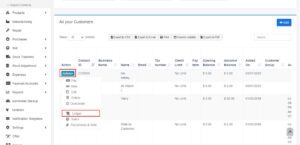
MyPosBook – All-in-one ERP Software System & Solution for Business, Best advanced stock inventory management, warehouse management, point of sale, invoicing & accounting application comes with lots of features out-of-box. You get most of the feature needed by small & medium sized businesses to simplify the time-consuming task of accounting & inventory management and instead focus on what really matters – Your Business. Adding Discount for Customer/Supplier on Balance due: Discount for balance due amount can be added for customer/supplier. Click the add discount button on the customer/supplier ledger screen

MyPosBook – All-in-one ERP Software System & Solution for Business, Best advanced stock inventory management, warehouse management, point of sale, invoicing & accounting application comes with lots of features out-of-box. You get most of the feature needed by small & medium sized businesses to simplify the time-consuming task of accounting & inventory management and instead focus on what really matters – Your Business. On clicking the button it shows a popup, enter the details and click save. The discounted amount will be accounted for in their ledger.
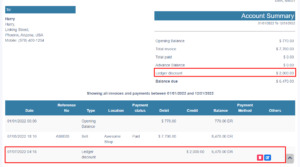
MyPosBook – All-in-one ERP Software System & Solution for Business, Best advanced stock inventory management, warehouse management, point of sale, invoicing & accounting application comes with lots of features out-of-box. You get most of the feature needed by small & medium sized businesses to simplify the time-consuming task of accounting & inventory management and instead focus on what really matters – Your Business. NOTE: This discount can only be added by the admin and not by other users. 2. Adding opening balance & payment for customer or supplier Adding opening balance & payment for customer or supplier Opening balance: Opening balance is the balance contact (customer or supplier) have at the beginning of using the software. Suppose you’re shifting the data from another software to UltimatePOS then the opening balance of the contact will be the balance amount which the contact has to pay/receive to/from you. Opening balance for customer = Amount the customer has to pay Opening balance for supplier = Amount you have to pay to the supplier. Adding Opening balance You can add an opening balance when adding/editing the supplier or customer. In the add contact screen, you will find the opening balance field.

MyPosBook – All-in-one ERP Software System & Solution for Business, Best advanced stock inventory management, warehouse management, point of sale, invoicing & accounting application comes with lots of features out-of-box. You get most of the feature needed by small & medium sized businesses to simplify the time-consuming task of accounting & inventory management and instead focus on what really matters – Your Business. View Opening balance payment To view the opening balance of contact, go to List Supplier/customer, go to view, and on the view page, you will find the opening balance & opening balance due.
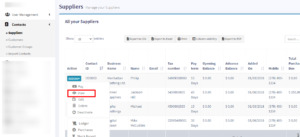
MyPosBook – All-in-one ERP Software System & Solution for Business, Best advanced stock inventory management, warehouse management, point of sale, invoicing & accounting application comes with lots of features out-of-box. You get most of the feature needed by small & medium sized businesses to simplify the time-consuming task of accounting & inventory management and instead focus on what really matters – Your Business. Pay or receive payment of opening Balance Adding payment of the opening balance is the same as any other payments. Go to list Customer/Supplier -> Actions -> Pay. It will open a popup modal where you can enter the payment amount.
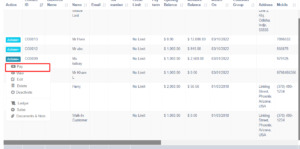
MyPosBook – All-in-one ERP Software System & Solution for Business, Best advanced stock inventory management, warehouse management, point of sale, invoicing & accounting application comes with lots of features out-of-box. You get most of the feature needed by small & medium sized businesses to simplify the time-consuming task of accounting & inventory management and instead focus on what really matters – Your Business.
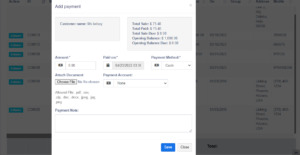
MyPosBook – All-in-one ERP Software System & Solution for Business, Best advanced stock inventory management, warehouse management, point of sale, invoicing & accounting application comes with lots of features out-of-box. You get most of the feature needed by small & medium sized businesses to simplify the time-consuming task of accounting & inventory management and instead focus on what really matters – Your Business. 3. Contacts Management (Supplier & Customers) Any contact can be supplier, Customer or Both (Supplier & Customers) Adding Suppliers & Customers
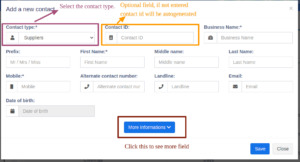
MyPosBook – All-in-one ERP Software System & Solution for Business, Best advanced stock inventory management, warehouse management, point of sale, invoicing & accounting application comes with lots of features out-of-box. You get most of the feature needed by small & medium sized businesses to simplify the time-consuming task of accounting & inventory management and instead focus on what really matters – Your Business.

MyPosBook – All-in-one ERP Software System & Solution for Business, Best advanced stock inventory management, warehouse management, point of sale, invoicing & accounting application comes with lots of features out-of-box. You get most of the feature needed by small & medium sized businesses to simplify the time-consuming task of accounting & inventory management and instead focus on what really matters – Your Business. Go to Contacts -> Suppliers or Customer Click on add new contact. Select contact type – Supplier/Customer/Both Based on the contact type selected – it will show the relevant fields. Fill the relevant details. Click on More More Information button to see more field. Pay Terms: This will help the system to notify you of any pending payments for suppliers & customers. You can specify pay term in either days or months. Customer Group: Credit Limit: This is the maximum amount of credit that can be given to the customer. If in any sales the credit exceeds this amount then it won’t allow selling on credit. Opening Balance: Opening balance of a customer or supplier before you start using UltimatePOS. So if there is any previous balance you can add here. Advance balance: Sometimes customer/supplier pay/takes money in advance. This wil show the amount of advance balance paid or take by the customer/supplier respectively. Viewing Suppliers & Customers To view details about a Supplier or Customer click on View button. It will show the complete details along with the relevant transactions (Purchases & Sales) for that contact. Pay Due amount: You can use this button to pay the due amount for a customer or supplier. This will pay the overall due amount for all invoices. 4. Advanced Balance (Supplier & Customers) Advanced Balance Advanced balance(to customers) is the sum of the amount that the business should pay for the customers. Advanced balance(to suppliers) is the sum of the amount that the suppliers should pay for the business. To add an advanced balance, Go to Customers -> customers/suppliers and click on the action button. Here you will find a pay option and click on it. Add payment pop up will be shown and add the required amount value and click on save button.
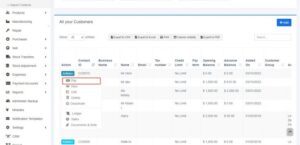
MyPosBook – All-in-one ERP Software System & Solution for Business, Best advanced stock inventory management, warehouse management, point of sale, invoicing & accounting application comes with lots of features out-of-box. You get most of the feature needed by small & medium sized businesses to simplify the time-consuming task of accounting & inventory management and instead focus on what really matters – Your Business
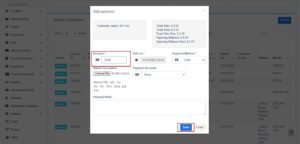
MyPosBook – All-in-one ERP Software System & Solution for Business, Best advanced stock inventory management, warehouse management, point of sale, invoicing & accounting application comes with lots of features out-of-box. You get most of the feature needed by small & medium sized businesses to simplify the time-consuming task of accounting & inventory management and instead focus on what really matters – Your Business.

MyPosBook – All-in-one ERP Software System & Solution for Business, Best advanced stock inventory management, warehouse management, point of sale, invoicing & accounting application comes with lots of features out-of-box. You get most of the feature needed by small & medium sized businesses to simplify the time-consuming task of accounting & inventory management and instead focus on what really matters – Your Business. Making sales/ purchase using advanced balance: To make a purchase or sale using this advanced balance, add a sale or purchase. Select the customer/supplier that you have added advanced balance. While making the payment select the advance option and save it.
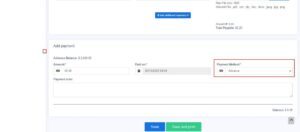
MyPosBook – All-in-one ERP Software System & Solution for Business, Best advanced stock inventory management, warehouse management, point of sale, invoicing & accounting application comes with lots of features out-of-box. You get most of the feature needed by small & medium sized businesses to simplify the time-consuming task of accounting & inventory management and instead focus on what really matters – Your Business. 5. Opening Balance (Supplier & Customers) Opening Balance Opening balance(to customers) is the sum of the amount that the customers have to pay for the business. Opening balance(to suppliers) is the sum of the amount that the business has to pay for the suppliers. Adding an opening balance To add an opening balance, Go to Contacts->customers/suppliers. Either select the add button or click on edit for an existing user. There you could find a more information button, click on that and add the opening balance amount to be added for that user.
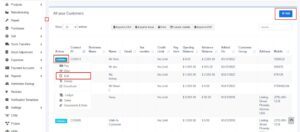
MyPosBook – All-in-one ERP Software System & Solution for Business, Best advanced stock inventory management, warehouse management, point of sale, invoicing & accounting application comes with lots of features out-of-box. You get most of the feature needed by small & medium sized businesses to simplify the time-consuming task of accounting & inventory management and instead focus on what really matters – Your Business.
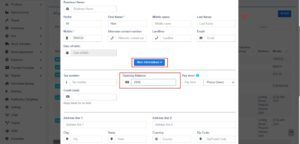
MyPosBook – All-in-one ERP Software System & Solution for Business, Best advanced stock inventory management, warehouse management, point of sale, invoicing & accounting application comes with lots of features out-of-box. You get most of the feature needed by small & medium sized businesses to simplify the time-consuming task of accounting & inventory management and instead focus on what really matters – Your Business. 5. Read the full article
#CRMSoftware#customerrelationshipmanagementsoftware#srmsoftware#supplierrelationshipmanagementsoftware
0 notes
Text
Expense Management in MyPosBook-ERP Software & ERP Solutions
Expense Management in MyPosBook - All-in-One-ERP Software & ERP Solutions for Business
Reports help you to get an overview of your entire business. To view report click on Reports & Select the report you want to view. Some Reports come filter relevant options to help you analyze your business better. 1. Expense Refund Expense Refund: To add a refund for an expense, add a new Expense with the “Is Refund” checkbox checked in the add/edit expense. You have to enter the refund amount and the refund payment details. The refunded amount will be added to the Net-Profit. 2. Adding expenses, Adding expenses for an employee or customer or supplier MyPosBook allows you to add expenses for an employee. Thie expenses can be Salary, Bonuses, Perks, travel expenditure or anything else. – Simply create a category for the expense you’re adding. Adding relevant categories helps you to classify expenses and analyze them. – Go to Add Expenses, fill the details, select the relevant category and select the employee name expense for fields. – Add the expense. – To view details of all expenses for an employee go to “Sales Representative Report” and select the User. It will show the total expenses for the employee. You can also view the list of expenses from there. Expense for Contact (Customer or Supplier): To add expense for a customer or supplier select the customer/supplier name from the expense for contact dropdown Read the full article
0 notes
Text
Inventory Management & Warehouse Management in MyPosBook-ERP System
Inventory Management & Warehouse Management in MyPosBook - All-in-One-ERP Software & ERP Solutions for Business
Adding Products Import/Export Products Delete Product (Bulk delete) Variations Product Units Product Category (Categorizing products) Product stock history Product expiry and related settings. Lot number Selling Price Groups (Sell in different prices: wholesale/retail or for different prices for different locations) Product Warranty Printing Labels Duplicate Product Correcting product stock mis-match or incorrect stock in different reports Bulk Edit Products Rack, Row & Position of product Opening Stock Enable bulk edit 1. Adding Products Adding Products Go to – Products > Add Products. Provide a Product Name, Brand, Units, Category Sub-category SKU: Add a unique SKU which will be used to identify the product & Print barcode in labels. Leave it empty to auto-generate it. You can also add a Prefix for auto-generated SKU. Steps to change the default SKU length:In order to change the default SKU length, make the following simple change in the code. 1. Open the file posappUtilsProductUtil.php. 2. Search for the function ‘generateProductSku’. 3. Change the default value 4 to any required length. Barcode Type: Select a barcode type, default/recommended is C128 option. We recommend changing if only if the product added already have an SKU number for it. Not For Selling: If a product is maked not-for-selling then it will not be displayed in POS or sales screen. This can be useful when using manufacturing module to make the ingredients as product not-for-selling also if you want to temporary disable selling for some products. Alert Quantity: Alert quantity is used to alert when remaining stocks reaches to this level or below it. Manage stock: Enable/Disable stock management at a product level. Product stock management is not required for services like Repairing, Hair Cutting, Web Development Printing. For items with Manage Stock Unchecked (disabled), you can sell them in unlimited quantities. Selling of service using MyPosBook Business Location: Select the business location(s) where this product can sold or purchased. Select Applicable tax for that product. Product Type: Single Product: Applicable for products with no variation with them then select single When selecting Single product – You will need to enter the Default product price including/excluding tax, Profit Margin % (you can set default profit margin from settings -> Business Settings; this will help to type % every time). Based on the profit margin it will auto calculate selling price excluding of Tax. You can also enter the selling price manually and it will auto adjust the profit margin for you. Variable Product:
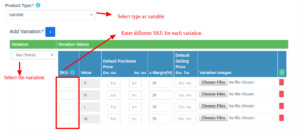
MyPosBook – All-in-one ERP Software System & Solution for Business, Best advanced stock inventory management, warehouse management, point of sale, invoicing & accounting application comes with lots of features out-of-box. You get most of the feature needed by small & medium sized businesses to simplify the time-consuming task of accounting & inventory management and instead focus on what really matters – Your Business. Applicable to a product having variations (like size or color or design or flavors etc) You can define variation templates from Products -> Variations. The advantage of creating variation is that it saves time to add same variations multiple time. When selecting Variable product – It will display different fields to add all variations and its related Purchase price, Selling Price. You have to select the variations from the dropdown and it will auto-populate the variations for that template. You can change the variable name, Variation values. To give same purchase price or selling price or profit for all variations of a product click on the double tick present in the first variation. Read more about adding variations

MyPosBook – All-in-one ERP Software System & Solution for Business, Best advanced stock inventory management, warehouse management, point of sale, invoicing & accounting application comes with lots of features out-of-box. You get most of the feature needed by small & medium sized businesses to simplify the time-consuming task of accounting & inventory management and instead focus on what really matters – Your Business.
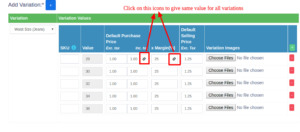
MyPosBook – All-in-one ERP Software & ERP Solutions – Best advanced stock inventory management, warehouse management, point of sale, invoicing & accounting application comes with lots of features out-of-box. You get most of the feature needed by small & Medium sized businesses to simplify the time-consuming task of accounting & inventory management and instead focus on what really matters – Your Business. Combo or Bundle Product
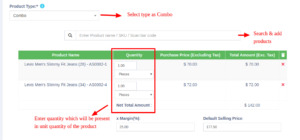
MyPosBook – All-in-one ERP Software System & Solution for Business, Best advanced stock inventory management, warehouse management, point of sale, invoicing & accounting application comes with lots of features out-of-box. You get most of the feature needed by small & medium sized businesses to simplify the time-consuming task of accounting & inventory management and instead focus on what really matters – Your Business. Adding a bundle product Combo product are also called bundle products. It is offering several products as one combined product. For example a product “Computer Set” can have: 1 PC Monitor + 1 PC CPU + 1 Pc Keyboard + 1 PC mouse So when someone buys Computer set she gets all the products in it. Stock of bundled product depends on stock of individual products present in that bundle. Example: if you have 5 PC Monitor, 4 PC CPU , 10 pc Keyboard, 50 PC mouse, the stock of Computer set will be 4 PC. When the bundle product is sold, stock of all products inside them is automatically deducted. Individual products present in bundle product can also be sold separately. Bundle products cannot be purchased, only individual products present in it can be purchased. Click on Save. You can edit a product. You can also Copy / Export to CSV, PDF or Excel file. Adding Products with multiple variations: If you have products which involve multiple variations like for example a Shirt can have Color & Size variation, then we have multiple ways to work with it: Solution 1, Create combined variation: Can a variation with a name “Color-Size” and add values like Red-Small, Red-Medium, Red-Large, etc, this can be used for while adding the Shirt. Solution 2, Create multiple Products: Create multiple different products like Shirt-Red, Shirt-Green, Shirt-Blue with size as variations. When you create multiple products you will NOT have to enter the same details multiple times, first, add the Shirt-Red with all size variations of it and then use the Duplicate Product action to copy the data. Assigning/remove locations of multiple products at once: Go to List Products and refer to this screenshot.

MyPosBook – All-in-one ERP Software System & Solution for Business, Best advanced stock inventory management, warehouse management, point of sale, invoicing & accounting application comes with lots of features out-of-box. You get most of the feature needed by small & medium sized businesses to simplify the time-consuming task of accounting & inventory management and instead focus on what really matters – Your Business. Deactivating & Activating Product: Refer to the screenshot.

MyPosBook – All-in-one ERP Software System & Solution for Business, Best advanced stock inventory management, warehouse management, point of sale, invoicing & accounting application comes with lots of features out-of-box. You get most of the feature needed by small & medium sized businesses to simplify the time-consuming task of accounting & inventory management and instead focus on what really matters – Your Business. Using Product barcode: Question: How can we use the product’s barcode instead of creating and printing new for every product? How can we use the brand’s barcode of the product instead of creating and printing new for every product? Answer: When creating a product, in the SKU field enter the barcode number of the product. This barcode will be used to identify the product in all screens like POS, Sales, purchases, reports, and others. How to add a product that already has a Barcode? Adding products that already have a barcode, follow the same steps as adding any other products. Go to add products Fill in all the product details IMPORTANT: in the SKU field scan or enter the barcode of the product. Adding product quantity or adding product stock For systematically managing your business, product quantities can be added in 3 ways: Adding Opening stock Adding purchases Manufacturing product: Useful for manufacturers, required manufacturing module. 2. Import/Export Products Import Products: Steps: Go to Products -> Import Products Download the template file. Fill all the information as per the displayed columns name & instructions. Don’t remove the heading from template file. Import the file Export Products:
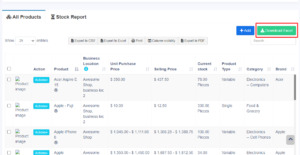
MyPosBook – All-in-one ERP Software System & Solution for Business, Best advanced stock inventory management, warehouse management, point of sale, invoicing & accounting application comes with lots of features out-of-box. You get most of the feature needed by small & medium sized businesses to simplify the time-consuming task of accounting & inventory management and instead focus on what really matters – Your Business. The products can be exported in excel/pdf formats from the list products screen. In the list products screen, click the download excel button. 3. Delete Product (Bulk delete) Deleting Products Deleting of a product will remove the products from the database. NOTE: This delete will not work if the product have some transactions related to it. Transaction can be Opening Stock, Purchase, Sales or Stock transfer of the product. It will show some error like: Product can’t be deleted because purchases related to this product exist Some products couldn’t be deleted because it has transaction related to it. Deleting individual product
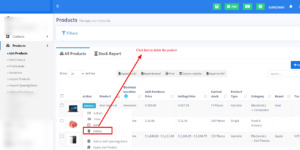
MyPosBook – All-in-one ERP Software System & Solution for Business, Best advanced stock inventory management, warehouse management, point of sale, invoicing & accounting application comes with lots of features out-of-box. You get most of the feature needed by small & medium sized businesses to simplify the time-consuming task of accounting & inventory management and instead focus on what really matters – Your Business. Bulk Delete multiple products
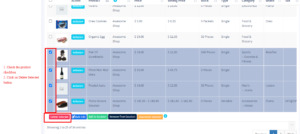
MyPosBook – All-in-one ERP Software System & Solution for Business, Best advanced stock inventory management, warehouse management, point of sale, invoicing & accounting application comes with lots of features out-of-box. You get most of the feature needed by small & medium sized businesses to simplify the time-consuming task of accounting & inventory management and instead focus on what really matters – Your Business. Delete product Errors: Some products couldn’t be deleted because it has transaction related to it: When a product has any transactions it cannot be deleted. Transactions can be either Sales, Purchase, or Adding opening stock. The best way to avoid such products is by deactivation them 4. Variations Products Variations can be added from Products -> Variations menu. These variations are used in variable products product.

MyPosBook – All-in-one ERP Software System & Solution for Business, Best advanced stock inventory management, warehouse management, point of sale, invoicing & accounting application comes with lots of features out-of-box. You get most of the feature needed by small & medium sized businesses to simplify the time-consuming task of accounting & inventory management and instead focus on what really matters – Your Business. Example of variation is for example, a Jeans can have multiple colors, so add variation called Colors and provide the value for it. As given in the image below. 5. Product Units Different Products have different units. MyPosBook allows you to add different units for products. Adding Units Go to Products -> Units Give the unit name, a short name, and choose if want the unit to allow decimals. Example: Name: Meter Shortname: Mtr. Allow Decimal: Yes. Allowing decimal allows you to purchase/Sell the product in decimal and vice-versa. Multiple Units: This can be useful if you purchase products in a different unit and sell it in a different unit. For example: Purchase in dozens and sell in pieces. Or purchase in boxes and sell in pieces. Steps: Add the lower unit from Add Unit Screen. For example pieces. Add the higher unit as per the screenshot: Check “Add as multiple of another unit” Read the full article
#inventorymanagementsoftware#pointofsale#pointofsalesoftware#possoftware#scmsoftware#supplychainmanagementsoftware#warehousemanagementsoftware
0 notes
Text
Point of Sales Management in MyPosBook-ERP Software & ERP Solutions
Point of Sales Management in MyPosBook - All-in-One-ERP Software & ERP Solutions for Business
Sales Order Selling (POS Screen), Credit Sales, Draft, Quotations & Suspended Sales. Tender Change or Change Return Featured Products in POS screen Using Ultimate POS for Selling of Services Sales Return Sales Subscriptions Cash Register Invoice Layout Displaying QR code in invoice Gift Receipt Invoice External URL Configuring keyboard shortcuts for POS screen Discounts by Brand, Category, Location Reward Points, Royalty points Types of Service Shipments, Home Delivery or parcel management Display product unit price in POS Product suggestion Cash Denomination 1. Sales Order What is a Sales Order? Sales Order is a document given by the supplier to the buyer against a Purchase Order by the buyer. A sales order contains the buyer invoicing details, delivery details, products, quantities, pricing, tax, discounts, payment terms, payment details, shipping charges if any, and other notes. Once the buyer agrees on the sales order, goods are shipped by the supplier. Sale order has multiple statuses: Ordered, Partial, Completed Enabling Sales Order To enable Sales Order, follow the below steps: Go to Settings -> Business Settings Sales tab -> Enable Sales Order Save it. Using Sales Order in MyPosBook Creating sales order After Enabling sales order, inside Sales you’ll find the Sales-Order menu. Go to add sales order, fill in all the details and save it. Stocks are not deducted for sales orders. Once a sales order is created you can print it and send it to the buyer for approval. Converting Sales Order to Sales On approval of sales orders, you can create sales from the sales order. Go to Sales -> Add sales, select the business location & Customer. On Selecting it will populate the list of all sales orders related to the customer on the “Sales Order” dropdown. Select the Sales Order and it will auto load the products for that order with the product’s price, tax, discounts applied automatically as the sales order. You can increase or decrease the quantity. 2. Selling (POS Screen), Credit Sales, Draft, Quotations & Suspended Sales.
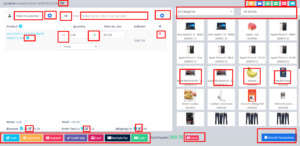
MyPosBook – All-in-one ERP Software System & Solution for Business, Best advanced stock inventory management, warehouse management, point of sale, invoicing & accounting application comes with lots of features out-of-box. You get most of the feature needed by small & medium sized businesses to simplify the time-consuming task of accounting & inventory management and instead focus on what really matters – Your Business. Interactions points in POS Screen. Selling Products, Changing Product Price, Tax & Discount, Lot number & Expiry Go to – Sell -> POS Selecting Customer: By default, there is “Walk-In Customer”. You can search for a customer by name/customer id or phone number or can add new customer by clicking the plus (+) button “Add Customer”. Searching & Adding Product: Enter Product Name Or scan the barcode to search the product. If multiple products are matched then it displays the dropdown of products, selects the product from it. Or if there is a single product then it directly gets added to cart.
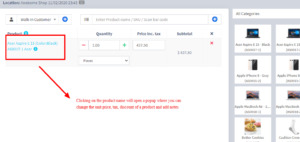
MyPosBook – All-in-one ERP Software System & Solution for Business, Best advanced stock inventory management, warehouse management, point of sale, invoicing & accounting application comes with lots of features out-of-box. You get most of the feature needed by small & medium sized businesses to simplify the time-consuming task of accounting & inventory management and instead focus on what really matters – Your Business. Changing Product Price, Tax & Discount for a product After the products get added, click on the product name to modify product price, tax & discounts. NOTE: Option for different tax in products will be shown only if Inline tax is enabled. You can enable it from Business Settings -> Tax -> Enable Inline Tax in purchase and sell Selecting Lot number for a product If lot number is enabled then it will show the option to select lot number. (Enabling Lot number) Selecting Expiry for a product Expiry Date: If the expiry date is enabled then it will show the option to select lot number. (Enabling expiry) Cancel Sales: To cancel the sales click on the cancel button. Cancel invoices are not saved in the system, so no stock will de deducted. To finalize the invoice click on Finalize – Add the payment options and save it. On save it will display an invoice printing option. NOTE: For invoice to print correctly – The Margins options should be set to “Default”. List of sales can be viewed from Sell -> List Sales. List of drafts can be viewed from Sell -> Drafts. Both Sell & Drafts can be edited to make any changes. Express Checkout: Express Checkout means the sale will be marked as Paid and the payment method will be cash. No separate payment screen will be displayed. Printing of invoice depends on the business location settings.
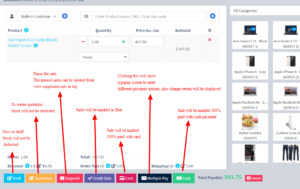
MyPosBook – All-in-one ERP Software System & Solution for Business, Best advanced stock inventory management, warehouse management, point of sale, invoicing & accounting application comes with lots of features out-of-box. You get most of the feature needed by small & medium sized businesses to simplify the time-consuming task of accounting & inventory management and instead focus on what really matters – Your Business. 100% Credit Sales To sell on credit to the customer you first need to enable this button by going to Settings -> Business Settings -> POS -> Show Credit Sale Button Then on the POS screen, you will be able to see a button “Credit Sale”, simply click this button to make sales on credit. Half Credit & half payment Sales: Suppose invoice amount is $1000, customers pays $700 cash and $300 is credit amount on him, then follow these steps: Click on multiple pay button Select the payment method and enter the amount paid by the customer. ($700 in our example) Click finalize payment. Now, the pending amount is automatically added as credit amount on him (or amount to be taken from the customer) Previous sale amount in Sales: If a sale is made for the customer for a subsequent time for the same product, the previous amount in which the product is sold will be shown for reference in add sale screen.
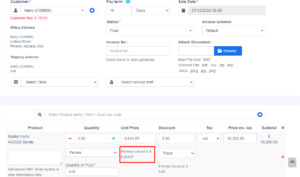
MyPosBook – All-in-one ERP Software System & Solution for Business, Best advanced stock inventory management, warehouse management, point of sale, invoicing & accounting application comes with lots of features out-of-box. You get most of the feature needed by small & medium sized businesses to simplify the time-consuming task of accounting & inventory management and instead focus on what really matters – Your Business. This feature can also be used for purchase of same products from a supplier. Draft & Quotation This is useful if you want to create a quotation before sales. Marking a sales as Draft or Quotations will not deduct the available stock. You can view all Quotations & Drafts from List Quotation or List Draft respectively. Existing draft/Quotation can be edited to make it as final sales. Suspended Sales Suspend Sales means unfinished sale or hold Sale. Suspended sales stock gets deducted from available stock. You can view all suspended sales by clicking on the Yellow Color button present in very top right of screen (above the date). Some Use Case of Suspended sales In a grocery store, if you have suspended button, you can suspend particular customers sales and entertain another customer, when his comeback you can proceed with his sale. In Restaurant, you can suspend the order of customers if not yet paid, and finish it when they finish eating and paid their order, so you can proceed to final sales. You can put Table 1, Table 2, Table 3… so when they finish it’s easy to identify table 3 going to pay. In hotel lots of customers check in stay for 2 nights and order some foods and customers say, just charge to room 024. So you can suspend their orders and edit if there is some additional order and suspend again. Until final it when they pay their bills. on Hotel, on Reference Number: Room 009, Room 012 Card / Multiple Pay / Cash Multiple Pay: Used when the customer wants to pay with different payment methods like some amount by card, some by cash and some other payment methods. This option is also used when the customer doesn’t pay the exact tender amount and you need to calculate the Return Change. Card: Used when the customer wants to pay the complete invoice by card. Cash: Used when customer pay the exact amount of invoice by cash. If the customer pays less or more amount then the invoice amount then use Multiple Pay to get change return. Adding payments from Contact Go to contact -> Suppliers. Click on actions for the supplier and it will show “Pay Due amount”, click on it and pay the amount. “Pay Due amount” this option is not displayed if there is no payment due. Rounding Mechanism for total Sales amount or total payable Rounding helps to round the total payable to nearest currency exchange available. To enable rounding go to Settings -> Business Settings -> Sales and choose the Amount rounding method Amount rounding method Round to nearest whole number: It will round the payable value to nearest whole number. For example 1.49 will be rounded to 1.00, and 1.51will be rounded to 2.00 Round to nearest decimal (multiple of 0.05): It will round the payable value to nearest decimal number which is multiple of 0.05. For example 1.49 will be rounded to 1.50, 1.51 will be rounded to 1.50, 1.59 will be rounded to 1.60, 1.54 will be rounded to 1.55 Similarly all other round to nearest decimal number works as per the multiplier. 3. Tender Change or Change Return Suppose during POS the total payment amount by a customer is $250, but the customer pays $300 cash. In this case, the cashier needs to return $50 cash to the customer. So, enter all these details in the system, follow the below steps: Click on the “Multiple Pay” button. It will open a popup Enter the paid amount by the customer ($300 here) On the right side, it will show a “Change Return” Amount. This amount needs to be returned to the customer Click on finalize button to save the sales. The change amount is shown in the invoice. To create a custom label for change return Go to Settings -> Invoice layout change the ‘change return label’ to a required label and save the changes. 3. Featured Products for POS screen Featured Products for POS screen Adding featured products helps you quickly access some products which are frequently or most commonly sold. To add featured products follow these steps: Go to Settings -> Business Locations. Add/Edit any business locations In add/edit screen you can select multiple products that can be featured in pos for this location.

MyPosBook – All-in-one ERP Software System & Solution for Business, Best advanced stock inventory management, warehouse management, point of sale, invoicing & accounting application comes with lots of features out-of-box. You get most of the feature needed by small & medium sized businesses to simplify the time-consuming task of accounting & inventory management and instead focus on what really matters – Your Business. Select feature products in add/edit business locations

MyPosBook – All-in-one ERP Software System & Solution for Business, Best advanced stock inventory management, warehouse management, point of sale, invoicing & accounting application comes with lots of features out-of-box. You get most of the feature needed by small & medium sized businesses to simplify the time-consuming task of accounting & inventory management and instead focus on what really matters – Your Business. 4. Using MyPosBook for Selling of Services MyPosBook POS can be used: Exclusively for Services or Exclusively for Product Selling (trading) Or Combination of Services & selling of Products. Selling Services Services are Intangible products. Example: Repairing, Salon & Spa services, Web Development, Accounting, banking, cleaning, consultancy, education, insurance, expertise, medical treatment, transportation and a lot more. 1. To add service Go to Add New Products. 2. Add the name of your Service, Like Computer Repair, Accounting, E-Commerce Development, Consulting, Plumber, Saving, Hair Cutting, etc. 3. While adding service-based products uncheck the “Manage Stock?“ option. When Manage stock is unchecked or disabled the stock for such products is not managed, because such a product doesn’t have a stock count with it. 4. If you want to add a description for such service like for example in computer repair you want to describe the problem for such service then check the “Enable Product description, IMEI or Serial Number” checkbox. Now to create invoice or receipt for such service 1. Go to Add Sales or POS screen. 2. Enter the name of the service. 3. If you have enabled “Enable Product description, IMEI or Serial Number”, then it will show you a popup to add a description. If you haven’t enabled description you can click on the button as shown the image below. 4. To print the description in the invoice, go to Setting -> Invoice Settings -> Invoice Layout. And click on the layout you’re using. Enable “Show sale description“. And Click on “Update” to update the invoice layout. Now it will display the Description you entered on the invoice or receipt. 5. Sales Return There are 2 ways of adding sales return First way: Edit existing invoice for the sales by going to edit the invoice and remove the product or reduce the quantity of the product. And save it. The system will automatically add the returned quantity back to stock. This is a simple & recommended way of doing. Second Way: Follow the screenshot below:
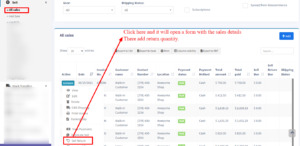
MyPosBook – All-in-one ERP Software System & Solution for Business, Best advanced stock inventory management, warehouse management, point of sale, invoicing & accounting application comes with lots of features out-of-box. You get most of the feature needed by small & medium sized businesses to simplify the time-consuming task of accounting & inventory management and instead focus on what really matters – Your Business. Question: Why sell return value not decrease the payment value from the parent invoice? MyPosBook will adjust these values in the Profit & Loss report. Regarding payment, users have to add a transaction for receiving payment from the customer and then paying them back. This way all the transactions are recorded. 6. Read the full article
0 notes
Text
Point of Sales Management in MyPosBook-ERP Software & ERP Solutions
Point of Sales Management in MyPosBook - All-in-One-ERP Software & ERP Solutions for Business
Sales Order Selling (POS Screen), Credit Sales, Draft, Quotations & Suspended Sales. Tender Change or Change Return Featured Products in POS screen Using Ultimate POS for Selling of Services Sales Return Sales Subscriptions Cash Register Invoice Layout Displaying QR code in invoice Gift Receipt Invoice External URL Configuring keyboard shortcuts for POS screen Discounts by Brand, Category, Location Reward Points, Royalty points Types of Service Shipments, Home Delivery or parcel management Display product unit price in POS Product suggestion Cash Denomination 1. Sales Order What is a Sales Order? Sales Order is a document given by the supplier to the buyer against a Purchase Order by the buyer. A sales order contains the buyer invoicing details, delivery details, products, quantities, pricing, tax, discounts, payment terms, payment details, shipping charges if any, and other notes. Once the buyer agrees on the sales order, goods are shipped by the supplier. Sale order has multiple statuses: Ordered, Partial, Completed Enabling Sales Order To enable Sales Order, follow the below steps: Go to Settings -> Business Settings Sales tab -> Enable Sales Order Save it. Using Sales Order in MyPosBook Creating sales order After Enabling sales order, inside Sales you’ll find the Sales-Order menu. Go to add sales order, fill in all the details and save it. Stocks are not deducted for sales orders. Once a sales order is created you can print it and send it to the buyer for approval. Converting Sales Order to Sales On approval of sales orders, you can create sales from the sales order. Go to Sales -> Add sales, select the business location & Customer. On Selecting it will populate the list of all sales orders related to the customer on the “Sales Order” dropdown. Select the Sales Order and it will auto load the products for that order with the product’s price, tax, discounts applied automatically as the sales order. You can increase or decrease the quantity. 2. Selling (POS Screen), Credit Sales, Draft, Quotations & Suspended Sales.

MyPosBook – All-in-one ERP Software System & Solution for Business, Best advanced stock inventory management, warehouse management, point of sale, invoicing & accounting application comes with lots of features out-of-box. You get most of the feature needed by small & medium sized businesses to simplify the time-consuming task of accounting & inventory management and instead focus on what really matters – Your Business. Interactions points in POS Screen. Selling Products, Changing Product Price, Tax & Discount, Lot number & Expiry Go to – Sell -> POS Selecting Customer: By default, there is “Walk-In Customer”. You can search for a customer by name/customer id or phone number or can add new customer by clicking the plus (+) button “Add Customer”. Searching & Adding Product: Enter Product Name Or scan the barcode to search the product. If multiple products are matched then it displays the dropdown of products, selects the product from it. Or if there is a single product then it directly gets added to cart.

MyPosBook – All-in-one ERP Software System & Solution for Business, Best advanced stock inventory management, warehouse management, point of sale, invoicing & accounting application comes with lots of features out-of-box. You get most of the feature needed by small & medium sized businesses to simplify the time-consuming task of accounting & inventory management and instead focus on what really matters – Your Business. Changing Product Price, Tax & Discount for a product After the products get added, click on the product name to modify product price, tax & discounts. NOTE: Option for different tax in products will be shown only if Inline tax is enabled. You can enable it from Business Settings -> Tax -> Enable Inline Tax in purchase and sell Selecting Lot number for a product If lot number is enabled then it will show the option to select lot number. (Enabling Lot number) Selecting Expiry for a product Expiry Date: If the expiry date is enabled then it will show the option to select lot number. (Enabling expiry) Cancel Sales: To cancel the sales click on the cancel button. Cancel invoices are not saved in the system, so no stock will de deducted. To finalize the invoice click on Finalize – Add the payment options and save it. On save it will display an invoice printing option. NOTE: For invoice to print correctly – The Margins options should be set to “Default”. List of sales can be viewed from Sell -> List Sales. List of drafts can be viewed from Sell -> Drafts. Both Sell & Drafts can be edited to make any changes. Express Checkout: Express Checkout means the sale will be marked as Paid and the payment method will be cash. No separate payment screen will be displayed. Printing of invoice depends on the business location settings.

MyPosBook – All-in-one ERP Software System & Solution for Business, Best advanced stock inventory management, warehouse management, point of sale, invoicing & accounting application comes with lots of features out-of-box. You get most of the feature needed by small & medium sized businesses to simplify the time-consuming task of accounting & inventory management and instead focus on what really matters – Your Business. 100% Credit Sales To sell on credit to the customer you first need to enable this button by going to Settings -> Business Settings -> POS -> Show Credit Sale Button Then on the POS screen, you will be able to see a button “Credit Sale”, simply click this button to make sales on credit. Half Credit & half payment Sales: Suppose invoice amount is $1000, customers pays $700 cash and $300 is credit amount on him, then follow these steps: Click on multiple pay button Select the payment method and enter the amount paid by the customer. ($700 in our example) Click finalize payment. Now, the pending amount is automatically added as credit amount on him (or amount to be taken from the customer) Previous sale amount in Sales: If a sale is made for the customer for a subsequent time for the same product, the previous amount in which the product is sold will be shown for reference in add sale screen.

MyPosBook – All-in-one ERP Software System & Solution for Business, Best advanced stock inventory management, warehouse management, point of sale, invoicing & accounting application comes with lots of features out-of-box. You get most of the feature needed by small & medium sized businesses to simplify the time-consuming task of accounting & inventory management and instead focus on what really matters – Your Business. This feature can also be used for purchase of same products from a supplier. Draft & Quotation This is useful if you want to create a quotation before sales. Marking a sales as Draft or Quotations will not deduct the available stock. You can view all Quotations & Drafts from List Quotation or List Draft respectively. Existing draft/Quotation can be edited to make it as final sales. Suspended Sales Suspend Sales means unfinished sale or hold Sale. Suspended sales stock gets deducted from available stock. You can view all suspended sales by clicking on the Yellow Color button present in very top right of screen (above the date). Some Use Case of Suspended sales In a grocery store, if you have suspended button, you can suspend particular customers sales and entertain another customer, when his comeback you can proceed with his sale. In Restaurant, you can suspend the order of customers if not yet paid, and finish it when they finish eating and paid their order, so you can proceed to final sales. You can put Table 1, Table 2, Table 3… so when they finish it’s easy to identify table 3 going to pay. In hotel lots of customers check in stay for 2 nights and order some foods and customers say, just charge to room 024. So you can suspend their orders and edit if there is some additional order and suspend again. Until final it when they pay their bills. on Hotel, on Reference Number: Room 009, Room 012 Card / Multiple Pay / Cash Multiple Pay: Used when the customer wants to pay with different payment methods like some amount by card, some by cash and some other payment methods. This option is also used when the customer doesn’t pay the exact tender amount and you need to calculate the Return Change. Card: Used when the customer wants to pay the complete invoice by card. Cash: Used when customer pay the exact amount of invoice by cash. If the customer pays less or more amount then the invoice amount then use Multiple Pay to get change return. Adding payments from Contact Go to contact -> Suppliers. Click on actions for the supplier and it will show “Pay Due amount”, click on it and pay the amount. “Pay Due amount” this option is not displayed if there is no payment due. Rounding Mechanism for total Sales amount or total payable Rounding helps to round the total payable to nearest currency exchange available. To enable rounding go to Settings -> Business Settings -> Sales and choose the Amount rounding method Amount rounding method Round to nearest whole number: It will round the payable value to nearest whole number. For example 1.49 will be rounded to 1.00, and 1.51will be rounded to 2.00 Round to nearest decimal (multiple of 0.05): It will round the payable value to nearest decimal number which is multiple of 0.05. For example 1.49 will be rounded to 1.50, 1.51 will be rounded to 1.50, 1.59 will be rounded to 1.60, 1.54 will be rounded to 1.55 Similarly all other round to nearest decimal number works as per the multiplier. 3. Tender Change or Change Return Suppose during POS the total payment amount by a customer is $250, but the customer pays $300 cash. In this case, the cashier needs to return $50 cash to the customer. So, enter all these details in the system, follow the below steps: Click on the “Multiple Pay” button. It will open a popup Enter the paid amount by the customer ($300 here) On the right side, it will show a “Change Return” Amount. This amount needs to be returned to the customer Click on finalize button to save the sales. The change amount is shown in the invoice. To create a custom label for change return Go to Settings -> Invoice layout change the ‘change return label’ to a required label and save the changes. 3. Featured Products for POS screen Featured Products for POS screen Adding featured products helps you quickly access some products which are frequently or most commonly sold. To add featured products follow these steps: Go to Settings -> Business Locations. Add/Edit any business locations In add/edit screen you can select multiple products that can be featured in pos for this location.

MyPosBook – All-in-one ERP Software System & Solution for Business, Best advanced stock inventory management, warehouse management, point of sale, invoicing & accounting application comes with lots of features out-of-box. You get most of the feature needed by small & medium sized businesses to simplify the time-consuming task of accounting & inventory management and instead focus on what really matters – Your Business. Select feature products in add/edit business locations

MyPosBook – All-in-one ERP Software System & Solution for Business, Best advanced stock inventory management, warehouse management, point of sale, invoicing & accounting application comes with lots of features out-of-box. You get most of the feature needed by small & medium sized businesses to simplify the time-consuming task of accounting & inventory management and instead focus on what really matters – Your Business. 4. Using MyPosBook for Selling of Services MyPosBook POS can be used: Exclusively for Services or Exclusively for Product Selling (trading) Or Combination of Services & selling of Products. Selling Services Services are Intangible products. Example: Repairing, Salon & Spa services, Web Development, Accounting, banking, cleaning, consultancy, education, insurance, expertise, medical treatment, transportation and a lot more. 1. To add service Go to Add New Products. 2. Add the name of your Service, Like Computer Repair, Accounting, E-Commerce Development, Consulting, Plumber, Saving, Hair Cutting, etc. 3. While adding service-based products uncheck the “Manage Stock?“ option. When Manage stock is unchecked or disabled the stock for such products is not managed, because such a product doesn’t have a stock count with it. 4. If you want to add a description for such service like for example in computer repair you want to describe the problem for such service then check the “Enable Product description, IMEI or Serial Number” checkbox. Now to create invoice or receipt for such service 1. Go to Add Sales or POS screen. 2. Enter the name of the service. 3. If you have enabled “Enable Product description, IMEI or Serial Number”, then it will show you a popup to add a description. If you haven’t enabled description you can click on the button as shown the image below. 4. To print the description in the invoice, go to Setting -> Invoice Settings -> Invoice Layout. And click on the layout you’re using. Enable “Show sale description“. And Click on “Update” to update the invoice layout. Now it will display the Description you entered on the invoice or receipt. 5. Sales Return There are 2 ways of adding sales return First way: Edit existing invoice for the sales by going to edit the invoice and remove the product or reduce the quantity of the product. And save it. The system will automatically add the returned quantity back to stock. This is a simple & recommended way of doing. Second Way: Follow the screenshot below:

MyPosBook – All-in-one ERP Software System & Solution for Business, Best advanced stock inventory management, warehouse management, point of sale, invoicing & accounting application comes with lots of features out-of-box. You get most of the feature needed by small & medium sized businesses to simplify the time-consuming task of accounting & inventory management and instead focus on what really matters – Your Business. Question: Why sell return value not decrease the payment value from the parent invoice? MyPosBook will adjust these values in the Profit & Loss report. Regarding payment, users have to add a transaction for receiving payment from the customer and then paying them back. This way all the transactions are recorded. 6. Read the full article
0 notes
Text
How to Register your Shop/Store/Business in MyPosBook-ERP System
How to Register your shop/Store/Business in MyPosBook - All-in-One-ERP Software & ERP Solutions for Business
Registering your shop/Store/Business in MyPosBook.com Setting Business Multiple Locations or Ware House or Storefronts 1. Registering a new shop/store/business Click on register business link on the welcome page. https://erp.myposbook.com/public/business/register Registering business involves multiple steps; Business Details, Tax details, and Owner details. Business Details: Fill out the relevant fields; select the appropriate currency & Time zone; click on Next. Time Zone & Currency can be different for different registered businesses. Tax Details: You should fill out at least one Tax name and Tax number. Tax is like GST/VAT which varies for different countries. Fill details & click on next. Owner Details: Provide asked details. Username & Password are used to login so make sure you remember them. The owner created during this registration will be admin of the business. More admin can be added/edited/deleted from user management section. Click on the register button and after successful registration, it will get redirected to login screen. Login with owner username/password created. 2. Setting Business Multiple Locations or Ware House or Storefronts MyPosBook comes with the option to handle multiple business locations or Warehouse or Storefronts for your business. To create a new Business Location / Storefront or warehouse go to “settings -> Business Locations” Fill the business details. Choose an Invoice scheme & Invoice Layout for the location.– When having multiple locations you will have to select the Location while adding purchases or in the pos screen. Inventory and transactions are managed separately for each location you create so that you can easily track and analyze them for each location. Disabling Business Location:To disable a business location click on Disable button present in List Business Location.NOTE 1: After a business location is disbabled any users assigned to that business location must be assigned to other non-disabled business location.NOTE 2: You must keep atleast 1 business location non-disabled. If all business location is disabled then the application will throw errors. 3. Setup different Invoice Scheme and Invoice Format for Each Store With MyPosBook you can configure the format for your invoice number. To configure go to Settings -> Invoice settings Click on Add and select a scheme format. Format can be XXXX or -XXXX You can also provide a custom prefix, invoice start number, number of digits in the invoice number. The preview box will display the preview according to the chosen option. You will need to set a default invoice scheme for a business to use it. Invoice Layout Invoice Layout helps you to create different invoice formats. To add a new invoice layout: Go to Settings->Invoice Settings->Invoice Layout->Add Give a unique distinguishable Layout name Add the text to be shown in the top/header of invoice. Generally, it can be your shop name, aligned center with Heading 1 format. Add other relevant details. You can show/hide address fields. You can mark a layout as default. The default layout is used when no layout is found for a location. Click on Save. To use an invoice layout in a location go to” Business Locations -> Edit” and assign the invoice layout. Invoice Design: In invoice layout, you will find options for invoice designs. Used for browser-based printing only & NOT print server-based printing. Slim design is used for thermal line printer-based printer. Changing invoice layout Select the invoice design name of the design you want to change like classic/elegant/detailed/slim etc. Tax Summary: To see the tax summary in invoice, go to add/edit invoice layout, and enter the “Tax Summary Label” option and it will show the tax summary in invoice. Total in words: To display total in words in the invoice Enable: Show total in words Choose “Word Format” Discounted Price: To display the discounted unit price and discount amount in the invoice, enable the following filed in invoice layout Discounted unit price label Discount label Display unit breakdown: To display the reduction summary of quantity from multiple units, enable the check box ‘show base unit details (If applicable)’. 4. Selling Price Groups (Sell in different prices: wholesale/retail or for different prices for different locations) With MyPosBook we aim to make it “One in All” POS/Stock Management Application. Selling price groups allow you to add different prices for a product. Sell at different prices: wholesale/retail Different prices for different locations Adding Selling Price Groups: Go to products -> Selling Price Group Click on “Add” button to add a new price group. For example Retail price or WholeSale price or Bulk Purchase price or Location 1 price etc as per your wish. You can view a list of selling prices in “Selling Price Group” screen. Adding price for different price groups:

MyPosBook – All-in-one ERP Software System & Solution for Business, Best advanced stock inventory management, warehouse management, point of sale, invoicing & accounting application comes with lots of features out-of-box. You get most of the feature needed by small & medium sized businesses to simplify the time-consuming task of accounting & inventory management and instead focus on what really matters – Your Business. In Add/Edit product screen in the bottom, you will find the button “Save & Add Selling-price-group price”. Click on that button. Note: this button will not be visible if there are no selling price groups. In the next screen, you will see the list of the product name (if variable product then all variations), the default price & selling price groups price. Enter the prices for it. Click on Save. Exporting & Importing selling price group: Go to Products -> Selling Price Group. First download the excel file with the selling price group by clicking on “Export Selling Price Group Prices” button. In the downloaded file change the price of products. Only selling price group prices of the product will be updated, not the SKU or name. Any blank price will be skiped. Then import the file. Selling at a particular price group: Go to POS. In the top, you will see the list of selling price groups. Select the one as per your requirement. Note: This will not be visible if there are no selling price groups or if a user is assigned only one particular price group only. Select the prie group & the selling prices for the product will be as per the price group. Assigning a user to a particular price group: Sometime you may want to assign a particular or few selected price group to a user. In that case, create a role with the desired permission & price group assigned. You must assign at least one price group for a role if that role has permission to sell. Assigning a price group to a Business Location Helps selling same product at a different price in different business location. Go to Add/Edit Business Location and select the Default Selling Price Group, if not selected then products default price will be used. FAQ? 1. How to hide the Selling Price Group in POS window to all cashiers In add/edit roles you can set which all selling price groups will be visible to that role. So in the cashier role, you can uncheck/remove permission for all other selling price groups except the one you want to show or use for the cashier. Read the full article
1 note
·
View note